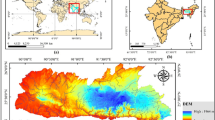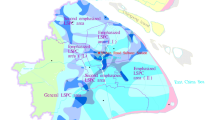Abstract
Debris flow is one of the most destructive mass movements. Sometimes regional debris flow susceptibility or hazard assessments can be more difficult than the other mass movements. Determination of debris accumulation zones and debris source areas, which is one of the most crucial stages in debris flow investigations, can be too difficult because of morphological restrictions. The main goal of the present study is to extract debris source areas by logistic regression analyses based on the data from the slopes of the Barla, Besparmak and Kapi Mountains in the SW part of the Taurids Mountain belt of Turkey, where formation of debris material are clearly evident and common. In this study, in order to achieve this goal, extensive field observations to identify the areal extent of debris source areas and debris material, air-photo studies to determine the debris source areas and also desk studies including Geographical Information System (GIS) applications and statistical assessments were performed. To justify the training data used in logistic regression analyses as representative, a random sampling procedure was applied. By using the results of the logistic regression analysis, the debris source area probability map of the region is produced. However, according to the field experiences of the authors, the produced map yielded over-predicted results. The main source of the over-prediction is structural relation between the bedding planes and slope aspects on the basis of the field observations, for the generation of debris, the dip of the bedding planes must be taken into consideration regarding the slope face. In order to eliminate this problem, in this study, an approach has been developed using probability distribution of the aspect values. With the application of structural adjustment, the final adjusted debris source area probability map is obtained for the study area. The field observations revealed that the actual debris source areas in the field coincide with the areas having high probability values on this final map.










Similar content being viewed by others
References
Atkinson PM, Massari R (1998) Generalized linear modelling of susceptibility to landsliding in the central Apennines, Italy. Comput Geosci 24:373–385
Ayalew L, Yamagishi H (2005) The application of GIS-based logistic regression for landslide susceptibility mapping in the Kakuda-Yahiko Mountains, central Japan. Geomorphology 65:15–31
Behrens T (2005) DEM analysis tool. http://www.arcscripts.esri.com/details.asp?dbid=10222
Bernknopf RL, Cambell RH, Brookshire DS, Shapiro CD (1988) A probabilistic approach to landslide hazard mapping in Cincinnati, Ohio, with applications for economic evaluation. Bull Int Assoc Eng Geol 25:39–56
Brenning A, Trombotto D (2006) Logistic regression modeling of rock glacier and glacier distribution: topographic and climatic controls in the semi-arid Andes. Geomorphology 81:141–154
Can T, Nefeslioglu HA, Gokceoglu C, Sonmez H, Duman TY (2005) Susceptibility assessments of shallow earthflows triggered by heavy rainfall at three catchments by logistic regression analyses. Geomorphology 72:250–271
Chien-Yuan C, Tien-Chien C, Fan-Chieh Y, Wen-Hui Y, Chun-Chieh T (2005) Rainfall duration and debris flow initiated studies for real-time monitoring. Environ Geol 47:715–724
Crowley JK, Hubbard BE, Mars JC (2003) Analysis of potential debris flow source areas on Mount Shasta, California, using airborne and satellite remote sensing data. Remote Sens Environ 87:345–358
Dai FC, Lee CF (2002) Landslide characteristics and slope instability modelling using GIS Lantau Island, Hong Kong. Geomorphology 42:213–238
Dai FC, Lee CF (2003) A spatiotemporal probabilistic modelling of storm-induced shallow landsliding using aerial photographs and logistic regression. Earth Surf Processes Landf 28:527–545
Dai FC, Lee CF, Zhang XH (2001) GIS-based geo-environmental evaluation for urban land-use planning: a case study. Eng Geol 61(4):257–271
Garcin M, Poisson B, Pouget R (2005) High rates of geomorphological processes in a tropical area: Remparts river case study (Reunion Island, Indian Ocean). Geomorphology 67:335–350
Glade T (2005) Linking debris-flow hazard assessments with geomorphology. Geomorphology 66:189–213
Gorsevski PV, Gessler P, Foltz RB (2000) Spatial prediction of landslide hazard using logistic regression and GIS. 4th international conference on integrating GIS and environmental modelling. Alberta p 9
Ishikawa Y, Kawakami S, Morimoto C, Mizuhara K (2003) Suppression of debris movement by forests and damage to forests by debris deposition. J For Res 8:37–47
Jade S, Sarkar S (1993) Statistical models for slope stability classification. Eng Geol 36:91–98
Jakob M (2005) A size classification for debris flows. Eng Geol 79:151–161
Jomelli V, Pech VP, Chochillon C, Brunstein D (2004) Geomorphic variations of debris flows and recent climatic change in the French Alps. Clim Change 64:77–102
Lee S (2004) Application of likelihood ratio and logistic regression models to landslide susceptibility mapping using GIS. Environ Manage 34:223–232
Lee S (2005) Application of logistic regression model and its validation for landslide susceptibility mapping using GIS and remote sensing data. Int J Remote Sens 26:1477–1491
Lee S, Min K (2001) Statistical analysis of landslide susceptibility at Yongin, Korea. Environ Geol 40:1095–1113
Malet JP, Maquaire O, Locat J, Remaitre A (2004) Assessing debris flow hazards associated with slow moving landslide: methodology and numerical analyses. Landslides 1:83–90
Malet JP, Laigle D, Remaitre A, Maquaire O (2005) Triggering conditions and mobility of debris flows associated to complex earthflows. Geomorphology 66:215–235
May CL, Gresswell RE (2004) Spatial and temporal patterns of debris-flow deposition in the Oregon Coast Range, USA. Geomorphology 57:135–149
Menard S (1995) Applied logistic regression analysis. Sage University paper series on quantitative applications in social sciences, vol 106. Thousand Oaks, p 98
Moore ID, Burch GJ (1986) Sediment transport capacity of sheet and rill flow: application of unit stream power theory. Water Resour Res 22:1350–1360
Moore ID, Wilson JP (1992) Length-slope factors for the revised universal soil loss equation: simplified method for estimation. J Soil Water Conserv 47:423–428
Moore ID, Grayson RB, Ladson AR (1991) Digital terrain modeling: a review of hydrological, geomorphological, and biological applications. Hydrol Processes 5:3–30
Nemec W, Kazanci N (1999) Quaternary colluvium in west-central Anatolia: sedimentary facies and paleoclimatic significance. Sedimentology 46:139–170
Ohlmacher CG, Davis CJ (2003) Using multiple regression and GIS technology to predict landslide hazard in northeast Kansas, USA. Eng Geol 69:331–343
Ozgul N (1976) Toroslarin bazi temel Jeoloji ozellikleri. Turkiye Jeooli. Kurumu Bulteni 19:65–78 (in Turkish)
Ozgul N, Bolukbasi S, Alkan H, Oztas Y, Korucu M (1991) Goller Bolgesinin Tektono-Stratigrafik Birlikleri. Ozan Sungurlu Sempozyumu Bildirileri, Ankara, 213–237s (in Turkish)
Rickenmann D (1999) Empirical relationships for debris flows. Nat Hazard 19:47–77
Scally FA, Owens IF (2004) Depositional processes and particle characteristics on fans in the Southern Alps, New Zealand. Geomorphology 69:46–56
Wen BP, Aydin A (2005) Mechanism of a rainfall-induced slide-debris flow: constrains from microstructure of its slip zone. Eng Geol 78:69–88
Wieczorek GF, Gori PL, Jager S, Kappel WM, Negussey D (1996) Assessment and management of landslide hazards near Tully Valley landslide, Syracuse, New York, USA. Proceedings of the 7th international symposium on landslides, Trondheim. Balkema, Rotterdam, pp 411–416
Wilson JP, Gallant JC (2000) Terrain analysis principles and applications. Wiley, Toronto, p 479
Zezere JL (2002) Landslide susceptibility assessment considering landslide typology. A case study in the area north of Lisbon (Portugal). Nat Hazard Earth Syst Sci 2:73–82
Acknowledgments
This research is supported by TUBITAK (The Scientific and Technological Research Council of Turkey) with a project number of 103Y144. The authors thank Prof Dr R. Ulusay for constructive comments on the manuscript and Z.A. Erguler for his supports during the field investigations.
Author information
Authors and Affiliations
Corresponding author
Rights and permissions
About this article
Cite this article
Tunusluoglu, M.C., Gokceoglu, C., Nefeslioglu, H.A. et al. Extraction of potential debris source areas by logistic regression technique: a case study from Barla, Besparmak and Kapi mountains (NW Taurids, Turkey). Environ Geol 54, 9–22 (2008). https://doi.org/10.1007/s00254-007-0788-5
Received:
Accepted:
Published:
Issue Date:
DOI: https://doi.org/10.1007/s00254-007-0788-5




